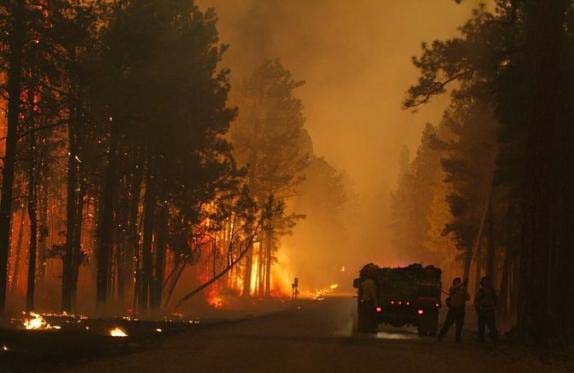
On a recent October day south and west of Alpine, AZ, James Nesslage and Brandon Billy were harvesting a bumper crop of cones from the top branches of a 100-foot tall ponderosa pine. That tree and others like it are survivors of the 538,049-acre Wallow Fire that burned in eastern Arizona and western New Mexico in 2011, most of it within the Apache-Sitgreaves National Forest. The cones being picked will yield the seeds needed to continue the restoration of parts of that vast burn.

Plans to restore the forest began before the Wallow Fire was contained. Initial estimates were that high burn severity over much of the fire area would result in natural regeneration being hampered by a lack of available seed trees.
To have the best chance of survival, seedlings must be grown from cones taken from parent trees in the area. Patrick Murphy, silviculturist on the Apache-Sitgreaves, explained:
Several factors are used in determining where cones are harvested and from which trees seed is collected. The forest has pre-established “seed zones”. These seed zones are geographic locations found throughout the forest. In collecting seed we take into consideration if the parent tree is free from insects, disease, defects, deformity, or forking. The tree should also exhibit superior height and diameter growth. We will plant seedlings in the same seed zone and elevation band where the parent tree is located.
Earlier in the year, there was a larger crew of 20 people harvesting the seed cones. Now as the cone picking season, which began in mid-August, was winding down, there were only two other people; father and son Randy and Brandon James, working that day. It would take two to three hours for each team to completely strip the tree of its cones. “The contract specifies eighty-percent (of the cones on each tree)” said Mr. Nesslage, “but we try to do better than that”. The pine that the James duo picked that morning barely produced a bushel of good cones while the tree that Mr. Nesslage and Mr. Billy harvested yielded over three bushels.

A general contractor in the construction business, Mr. Nesslage came across a solicitation for a seed cone harvesting contract on the Federal Business Opportunities website and thought it was a chance to put some of his climbing experience to good use. “Go camping, climb trees and get paid for it! Sweet!” was his reaction. He was awarded a contract and started picking in 2012. He admitted that the learning curve was a little steep at first but was able to complete the harvest. The cone crop in 2013 was poor and was not picked, so when Mr. Nesslage’s teams returned to the woods this year, not only was there more to harvest, they had a larger crew and more knowledge of how to do the job better and more efficiently.

After picking, the cones are sent to the Forest Service’s Lucky Peak Nursery outside of Boise, ID where the seeds are extracted, planted, and raised to seedlings. After growing for two years, the small trees are returned to Arizona for planting.
This summer, the ponderosa pine seedlings grown from the 2012 harvest were planted on 240 acres of the Apache-Sitgreaves’ Springerville Ranger District. When asked about the forest’s overall plan on replanting, Mr. Murphy replied: “The forest intends to plant 400 acres a year for the foreseeable future. It needs to be remembered that not all 500,000+ acres of the Wallow fire burned completely to the ground leaving a moonscape. Many acres burned with a low severity leaving a healthy overstory. Aspen is also regenerating nicely.”



The Wallow Fire burned in eastern Arizona and western New Mexico.
There was a time, many moons ago, we (USFS) harvested cones with .22 cal rifles. That was much safer than climbing.
And I’ll bet you had to be a better than decent marksman to be productive.
Actually, wasn’t that hard. Aimed for small branches that had multiple cones. It got much easier though when we started following timber sales about and getting the cones at ground level after fallers had been in an area. But…who has timber sales anymore eh?